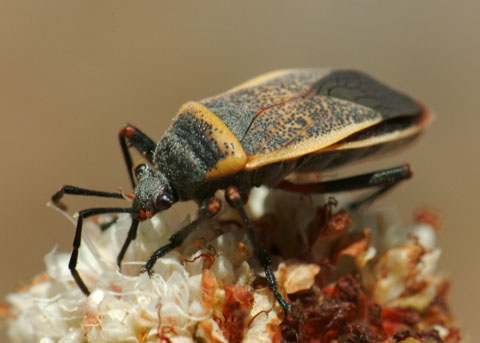Bordered Plant Bug
By Andrea Peck UCCE Master Gardener
My plants are covered in black and orange bugs—should I be worried?
Your plants may be experiencing life with the bordered plant bug (Largus cinctus). The bordered plant bug is often confused with the boxelder bug and a number of other true bugs, but the dramatic coloring is a dead giveaway. Adults sport a deep gray-blue body color with an orange trim outline. Their “tail end” is dark black and semi-diamond shaped. When full grown, the bug can reach up to 1/2” in length, so you won't need your magnifying glass for this insect. The nymphs are smaller and similarly eye-catching, with a metallic blue body and one red dot in the center of their back. Certainly, they are striking to behold, but are they problematic?
This insect is generally not a major menace, particularly when it comes to your ornamentals. But, you may keep a sharp eye on them when it comes to your fruits and flowers. The bordered plant bug is a gourmand when it comes to homegrown delicacies such as strawberries, peaches, plums and, well, anything else that is juicy. In general, true bugs come with standard-issue mouthparts that include the capability of piercing their next meal, making a slushie of sorts, then sucking it up with their bring-your-own straw apparatus. Despite their MacGyver-type ingenuity, these pests are not considered enough of a threat to warrant chemical control.
You may notice a proliferation of this bug in the summertime. After overwintering, females lay eggs in the spring. Eggs hatch in about 14 days and nymphs typically reach adulthood during the summer. Should the bordered plant bug become a nuisance, hand-picking, or shaking them off into a container is recommended. A sharp spray of water may discourage the little creatures as well. For those who prefer machinery, try using a shop-vac especially on hardscape or where more sturdy flora such as trees and bushes are concerned. More cautious types may prefer exclusion methods, such as row covers or netting material.
